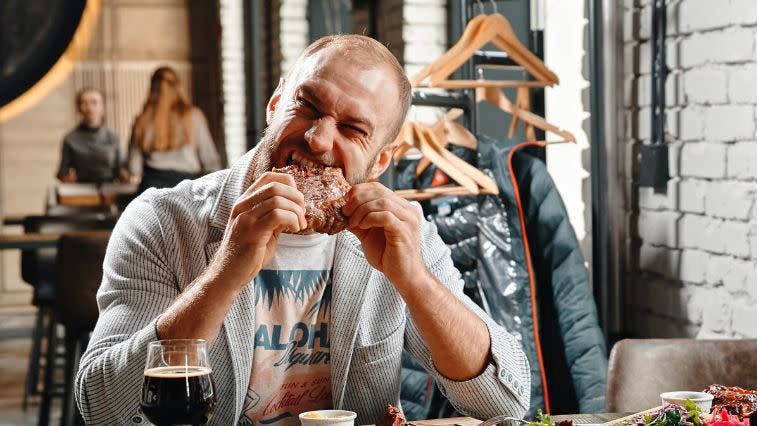Why You Might Be Building Lean Muscle Wrong (& How to Do It Right)
Our content strives to support, inform, and motivate you to meet your health goals. We want to be your trusted source of expert- and science-backed info dispensed in simple, actionable ways. Read our Editorial Guidelines.
As a certified personal trainer and nutritionist, my clients often tell me they want to lose fat and gain lean muscle. This requires a dance between losing fat and gaining muscle. While it’s possible to do both at the same time, it’s difficult due to their different dietary needs.
There’s no way around it: In order to have lean muscle that shows, you have to reduce your body fat. Our bodies have different types of fat. Visceral fat is the fat around our organs, subcutaneous fat is under our skin, and intramuscular fat is the fat in our muscles. Lean muscle is muscle with a low intramuscular fat percentage.
To get that lean muscle look, you likely need to cut excess fat from all three fat categories.
I’ve found that clients who try to reduce fat and build muscle at the same time end up frustrated and more likely to give up. This is why I tell my clients to think of lean muscle gain as a two-step process that starts with a fat-reduction plan.
Common Mistakes and How to Correct Them
My client Beth came to me frustrated. She wanted to drop fat and “tone” up. She had been doing what we’ve all been told: Eat less and do hours of cardio. She lost some weight at first but found she was fatigued and weak. Beth was on board with losing fat first, but knew what she was doing wasn’t working.
I first assessed Beth’s baseline calorie needs and her body fat percentage. Figuring out your exact body fat percentage can be difficult without a DEXA scan or hydrostatic method of body composition analysis. But, you can get an idea of where you’re at with an inexpensive handheld body fat caliper. Beth had roughly 32% body fat. The recommended body fat percentage for a woman like Beth was between 25–31%.
Nutrition
As with everything, nutrition is where it all starts! Beth was already eating a calorie deficit, which would help facilitate weight loss but it wasn’t a great plan for specifically targeting fat loss. As a result, she was also losing muscle. Beth didn’t really know where to start so she went for things labeled “low fat” or “low calorie.” She was eating some better options too, but not enough. This was making her feel hungry and crave junk food.
I kept Beth in a calorie deficit but increased her protein and fiber and cut out all the highly processed (and inflammatory) foods from her diet. She found that she wasn’t as hungry now that her body was getting what it needed. I explained to Beth that while eating a calorie deficit is important for fat loss, it’s only part of the equation.
A 2018 Stanford University study showed that the quality of what you eat matters when it comes to weight loss. Study participants who consumed the least amount of unhealthy fats, sugary drinks, and ultra-processed foods while eating lots of vegetables lost the most weight — regardless of whether they followed a low-fat or low-carb style of eating.
I recommended that Beth eat lean proteins, lots of vegetables (especially dark leafy greens), fruits (mostly berries), whole grains, and healthy fats.
Exercise

Beth was exclusively doing cardio, mostly running. Cardio has many excellent health benefits and it does help with fat loss. But for overall lasting fat loss, you’re going to need more than just steady-state cardio (cardio that is a paced, repetitive motion).
I wanted Beth to do some cardio but in a time-efficient way. I introduced Beth to high-intensity interval training or HIIT. A good HIIT workout will alternate between dynamic movements like plyometrics and strengthening moves like squats or push-ups. Because they’re so intense, you can get similar benefits in less time than other cardio activities.
One study showed that HIIT workouts were more effective than steady-state cardio in reducing abdominal/visceral fat, especially in postmenopausal women.
Beth did one to two HIIT workouts a week and, on strength training days, would start and end her sessions with 10 minutes of a paced cardio.
The meat of her workouts was strength training. Muscle mass increases your metabolic rate, or how many calories you burn while at rest. If you want to lose weight and keep it off, you’ll want to have a good amount of muscle and the only way to do that is strength training.
For Beth, we focused on compound movements, which are exercises like squats that use more than one joint and muscle group. We also did some isolated movements, which use only one joint and muscle group, like bicep curls. This helped us make sure we were overloading the muscle and hitting everything. If you don’t overload your muscles, they won’t respond to the stress (meaning you won’t see the results you want).
With this combination of proper nutrition and training, Beth reduced her body fat percentage down to 28% in approximately 4 months! Keep in mind that everyone loses weight differently. So don’t get frustrated if it takes you longer to reach your goal. Beth was happy with this level of fat loss and now wanted to get stronger. It was time to gain more of that lean muscle!
How to Switch From a Cut to a Gain
The switch from cutting fat to gaining muscle is not as drastic as you may think. The types of food Beth ate didn’t change. The only real change was she ate more!
Now that doesn’t mean she could over eat. On the days she worked out, she increased her calories by around 500. This is equal to about one extra meal or a couple of snacks a day. On her rest days, she ate about 200 calories more, or the equivalent of a snack. These snacks and meals were all high in protein. The amino acids that make up protein are what helps our bodies repair, maintain, and build muscle tissue. So, protein is required for the gain process.
Beth kept her 10- to 20-minute cardio sessions, but we eliminated the HIIT workouts. As mentioned, HIIT is great for burning a lot of calories in a short amount of time, but with our gain-muscle goal, we no longer need that. Instead, we focused completely on strength training. We increased the weight and reps as she progressed.
I get asked a lot by clients if they should increase weights or reps, and when to do so. The answer varies from person to person, and will vary at different times in your training. I highly recommend getting a certified personal trainer to help you design a program that will keep you from spinning your wheels.
Where to Start
According to research published in the American Journal of Clinical Nutrition, a healthy body fat percentage for women between 20–40 years old is between 21–30%. For men in the same age bracket, it’s between 8–19%. If you’re above this, then I recommend starting with the fat-loss phase. It’ll allow you to see the muscles you already have and will help you improve your overall health.
Nutrition for the Cut

Eat nutrient-dense foods: Lean proteins (fish, poultry, beans, quinoa, soy), fruits low on the glycemic index such as berries, vegetables (plenty of leafy greens), and whole grains (oats, barley, brown or wild rice). You can add small amounts of dairy or plant-based dairy alternatives for extra calcium and protein. Stick to plain yogurt and kefir.
Keep a food log. You don’t need to count calories, but log what you eat while you’re learning how to eat correctly. Our perception of what we have eaten versus reality is often very different. Logging can help us keep on track and spot problem areas.
Do not drastically restrict your calories. This is dangerous and will ultimately backfire on you!
Write down why you’re eating. If you’re an emotional eater, this is vital! But even if you are not, this can help you to get in tune with your body’s needs. We often eat when we’re really thirsty or tired. Making a simple note in your log can help you check in with your body.
Find your maintenance baseline calorie requirements. Even if you’re not counting calories, you want to get an idea what your daily requirements are.
Pay attention to portion sizes.
Avoid ultra-processed foods, added sugars, alcohol, and fast food (particularly fried).
Talk with a nutrition coach or your doctor about if an eating or intermittent fasting schedule is right for you.
Drink water! The amount of water a person needs varies from individual to individual. But most people are not getting anywhere close to enough. Start your day with a big glass of water. Yes before the coffee! And drink water continuously throughout the day.
Avoid sugary drinks such as sodas and juices.
Plan and prepare your meals and snacks. Choose what meals are the most challenging for you to eat right and prep those.
Workouts for the Cut
Strength train 3–4 days a week, working each major muscle group twice a week if possible. Five or more days is OK, but I recommend working with a trainer to help make sure you don’t risk overtraining or injury.
Take rest days! Skipping rest days will send your results flying backwards. Your body needs time to recover.
Work your muscles to fatigue, not failure. Fatigue means you’re shaking, having a hard time maintaining form, but are still able to move through the motion. Failure is your muscles completely collapsing, leaving you unable to move through the motion. Some coaches still encourage going to failure, but in my experience, it increases the risk of injury. Fatigue will get you great results without harm.
HIIT workouts 1–2 times per week. There are a lot of workouts out there claiming to be HIIT that are not. Work with your trainer to make sure you’re doing it right.
Prioritize sleep.
Strive for consistency. Not in the mood to work out? Do it anyway. Even if just a little. Consistency is the magic bullet for success.
Nutrition for the Gain

Add 200–500 more calories a day to your diet of mostly lean protein. The American College of Sports Medicine recommends 1.2–1.7 grams of protein per kg of body weight per day when you want to build muscle. If you’re not a numbers person, try to include protein in every meal and snack you eat.
Continue to log your food, drink your water, and stay away from the junk. You know the score!
Workouts for Gaining Lean Muscle
No more HIIT workouts.
Strength train 5–6 days a week.
Workouts that progressively overload the muscles. Increase reps and weight to stimulate muscle growth.
Change your workout plan every 4–6 weeks. This will keep your body from adapting. Working with a trainer can help take away the guesswork here!
Choose workouts that include supersets and drop sets. For supersets, pick two or three exercises that target the same muscle group in a different fashion and perform those back to back with little to no rest in between. For drop sets, start with the heaviest weight you can lift and do as many reps as you can until your muscles fatigue. Then drop down to the next lower weight and do the same. Continue until you’re doing bodyweight only.
And of course… consistency!
In Closing
The plan above is what I gave to Beth and many other clients from all walks of life. While it isn’t rocket science, it is challenging and everyone is different. I highly recommend finding a personal trainer who has experience working with clients like yourself. Having someone in your corner to take away a lot of the guesswork can keep you from frustration and failure.
Working out isn’t just hard physically. It’s a mental game as well, and a good coach can help you manage that — and even make the workouts enjoyable!